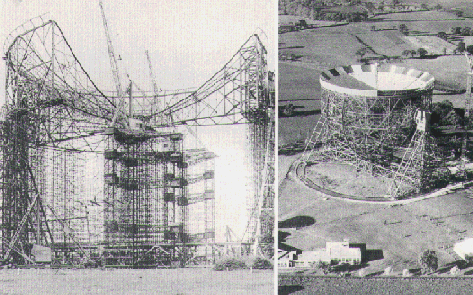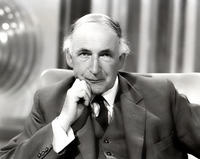Construction of the Lovell Telescope
Few scientists get the chance, at a relatively young age, to open up vast new areas of research. One such person is Sir Bernard Lovell, the creator of the giant 76-m (250ft) radio telescope at Jodrell Bank. The story begins in 1945 when Dr Lovell (as he then was) returned to the University of Manchester after working on radar during the war. He was seeking to continue his pre-war research in cosmic rays - energetic particles coming from space - by means of an ex-army radar transmitter. He needed a quiet observing site away from the radio interference of the city and was directed to the University's botanical station at a little known place called Jodrell Bank, 20 miles south of Manchester.
By Christmas, Lovell's radar equipment was operating at Jodrell Bank, but the radar echoes were coming not from cosmic rays but from meteors. For the next few years, meteor astronomy was to be a major concern at Jodrell Bank, and many important discoveries were made, including the existence of daytime meteor showers and confirmation that meteors were members of the solar system.
The transit telescope

The aerial of the 66-m transit telescope was carried on top of this adjustable pole
Lovell realised that much larger aerials were required if the detection of cosmic rays was ever to be achieved and in 1947 the Jodrell Bank group constructed a huge paraboloidal reflector from scaffolding poles and many miles of steel wire. The bowl, 66 metres (218 feet) in diameter, lay on its back on the ground,its size fixed by boundaries of the field. This `transit' instrument could only see a small portion of sky directly overhead, but it was sufficient for its intended purpose. In fact, no cosmic rays were ever detected. Instead, Lovell and his colleagues were drawn to the mysterious sources of radio waves far out in the universe, and eventually used the transit telescope to make the first detection of radio waves from the Andromeda galaxy. These new discoveries encouraged the Jodrell Bank astronomers to consider an even more ambitious project.
Design of a giant telescope
Together with Charles Husband, a Sheffield consulting engineer, Lovell laid plans for a new telescope with a 76-m bowl that could be pointed to any part of the sky. The telescope was originally designed to work at the comparatively long wavelengths of 1 to 10 metres. That meant that the surface needed be accurate only to within a few inches and could be constructed of 5-cm open wire mesh.
But events in a new field of science can move very fast. In 1951 radio astronomers around the world made the first detections of 21-cm emission from hydrogen atoms in the Milky Way, an observation that held out great promise for Galactic research (see page 10). It was obvious that the telescope would be greatly handicapped if it could not work at these shorter wavelengths. So even while the contractors were setting up their cranes the telescope was being redesigned. The wire mesh was discarded in favour of a more accurate, solid steel surface, made from 7100 welded panels, 2mm thick, and the supporting structure of the bowl was completely redesigned. It was a decision that was to prove its worth in the years to come.

Left:The Mark 1 radio telescope under construction, Right:The Mark 1 telescope is refurbished to become the Mark IA
The Mark I starts work
After a series of seemingly endless technical and financial problems, vividly related in Bernard Lovell's book The Story of Jodrell Bank, the telescope began trials in the summer of 1957. Within months the telescope, which had become known as the Mark I, proved itself in an unexpected and spectacular fashion. The Soviet Union had just launched the first space satellite, Sputnik I. and the Mark I was the only telescope in the world able to track the satellite's carrier rocket by radar. During the coming year the telescope was in great demand for tracking and commanding space probes from both the Soviet Union and the United States, although these activities have always been a minor part of the telescope's work.
In 1960 the outstanding debts on the telescope were cleared by donations from Lord Nuffield and the Nuffield Foundation, and accordingly the Jodrell Bank Experimental Station became officially known as the Nuffield Radio Astronomy Laboratories.
From the Mark I to the Lovell Telescope
But by the late 1960s the telescope was showing signs of wear and tear. In 1969 the railway track was renewed. Between August 1970 and November 1971 a new reflecting surface was placed above the old reflector and two circular wheel girders were constructed beneath the bowl to support much of its weight. The new, smoother surface meant that the telescope could operate at the shorter wavelengths (down to 6cm) that were becoming available with improved radio receivers and amplifiers. Jodrell Bank effectively had a new telescope - the Mark IA
In a close brush with disaster, the telescope narrowly escaped serious damage during the heavy storms of January 1976. The diagonal bracing girders added soon afterwards were the last major engineering work on the telescope. It has continued to operate without modification for almost two decades.
On the occasion of its thirtieth anniversary in 1987, the Mark IA was renamed the Lovell Telescope in honour of its creator.
Radio waves
Radio waves are just one part of a wide band of waves, including light waves, called the electromagnetic spectrum. All electromagnetic waves travel at the speed of light, 300 000 kilometres a second.
Waves can be described by the distance between crests, the Wavelength, or by the number of vibrations every second, the frequency. In radio astronomy, wavelengths range from a few millimetres up to several metres. Frequencies are measured in megahertz (MHz, a million vibrations a second) or gigahertz (1 GHz = 1000 MHz).
Wavelength and frequency are related by: Wavelength (in m) x frequency (in MHz) = 300.
The direction of the plane in which the wave vibrates defines the polarization.
The Earth's atmosphere is not transparent to all wavelengths. Only visible and radio waves can readily reach the ground from space. Infrared waves can be observed from high mountains, but ultraviolet, x-ray and gamma ray astronomers have to put their telescopes on spacecraft since those waves cannot penetrate the atmosphere. Radio astronomers are fortunate in being able to do all their work from the ground where it is much easier to build very large instruments such as the Lovell Telescope.

Like all waves, a radio wave has crests and troughs



